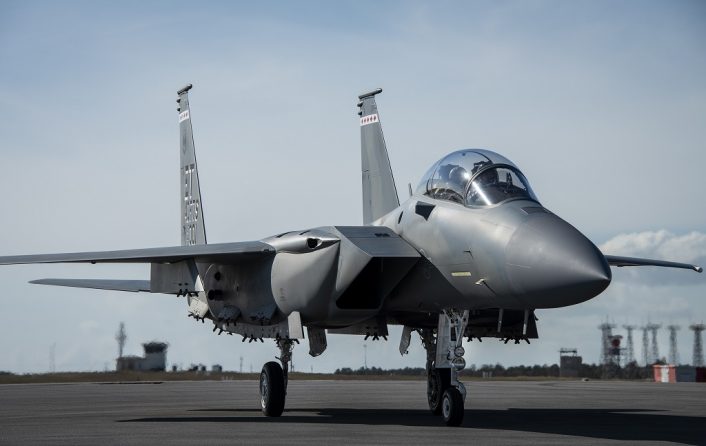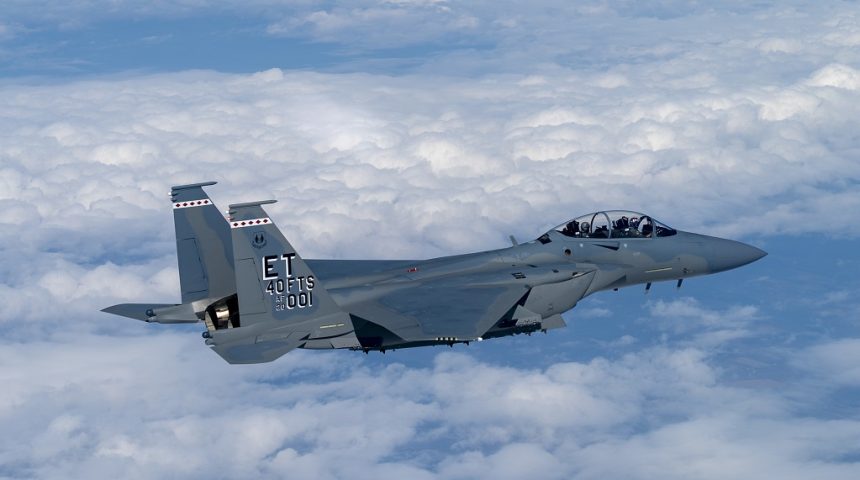The name for the newest aircraft of the U.S. Air Force has been announced today during the official rollout ceremony: F-15EX “Eagle II”.
Today the U.S. Air Force held an official rollout ceremony at Eglin Air Force Base (Florida) for its newest fighter aircraft delivered last month. At the end of the ceremony, which was livestreamed on Eglin AFB’s Facebook page, Lt. Gen. Duke Richardson, Military Deputy for the Office of the Assistant Secretary of the Air Force for Acquisition, Technology, and Logistics, announced the name that was chosen for the F-15EX: “Eagle II”.
Brig. Gen. Scott Cain, the Commander of the 96th Test Wing, introduced the ceremony describing the feats of the Eagle over its long service life: ”The F-15, with each of its models, has been a venerable workhorse for the United States Air Force and its allies for decades. It’s proven itself time and time again with its unmatched versatility and lethality in combat and its deterrent capability in peacetime. So it stands to reason then that the EX will build upon that legacy”.
Lt. Gen. Richardson was then called up to talk about the new fighter aircraft in its initial speech, reminding the Eagle, even with its legendary reputation thanks to its numerous achievements, is not immortal: “Undefeated in aerial combat, the F-15 Eagle epitomized the air superiority in the minds of our adversaries, our allies and the American people for over 45 years, but it was not meant to fly forever”.
He then proceeded to describe the actual precarious situation of the F-15C/D fleet: “The F-15C and D fleets in the current state place us at great risk, with 75% of the fleet is flying beyond its certified service life and 10% grounded due to structural integrity issues. Projected modernization and service life extension of the F-15C and D fleets is cost-prohibitive for a platform with an average age of over 37 years, diminishing combat capability over that time”.
The first F-15EX Eagle II, painted in the classic F-15C/D Eagle camouflage, arrived at Eglin AFB on March 11, 2021, a day after it was officially accepted at Boeing’s St. Louis facility, becoming the first Eagle to be delivered to the Air Force in 17 years. The aircraft is assigned to the 40th Flight Test Squadron for the developmental testing (DT) and will be joined soon by the second F-15EX that will be assigned to the 85th Test and Evaluation Squadron for the operational testing (OT). The two units will work together to complete the combined developmental and operational testing simultaneously.
The aim of integrated testing is to ensure the EX is delivered to the warfighter as soon as possible, while ensuring the aircraft meets test objectives. This combination of Eglin’s testers allows the teams to identify any system issues early on, so they can be addressed before the F-15EX’s increased production and delivery to the squadrons.
Initial testing will focus on ensuring the software and avionics systems integrate well with the aircraft’s features like the advanced cockpit and controls, as mentioned by the Air Force last year. To expedite the testing needed to declare the F-15EX ready for operations, the team at Eglin will use previous testing data from F-15 foreign military sales variants (like the F-15SA and F-15QA) and U.S.-only subsystems and Operational Flight Program software.
As already reported here at The Aviationist, the new Eagle II, developed from the F-15QA that was until now the most advanced Eagle variant, comes from a series of needs mainly emerged after the National Defense Strategy directed the U.S. armed services to adapt to the new threats from China and Russia. The aircraft, while extremely similar to the QA variant, features some US-only capabilities like the new AN/ALQ-250 Eagle Passive Active Warning Survivability System (EPAWSS) electronic warfare and electronic surveillance system and Open Mission Systems (OMS) architecture.
The aircraft presents many differences compared to the F-15C that it will replace. For an instance, the F-15EX is a two seats aircraft, which will have the option to fly with a single pilot or with both pilot and Weapons Systems Officer (WSO), while the -C model is mainly single seat and has a dedicated two seats -D variant for training. Originally both a single and two seat variants were proposed, called F-15CX and F-15EX respectively.
Another difference is that the F-15EX has a full glass cockpit equipped with a 10×19-inch touch-screen multifunction color display and JHMCS II both in the front and rear cockpit, Low Profile HUD in the front, stand-by display and dedicated engine, fuel and hydraulics display, in addition to the standard caution/warning lights, switches and Hands On Throttle-And-Stick (HOTAS) controls, as opposed to the F-15C that it is going to replace, which has a mainly analogic cockpit with some new displays added in the recent years.
The systems are powered by the Advanced Display Core Processor II, reportedly the fastest mission computer ever installed on a fighter jet, and the Operational Flight Program Suite 9.1X, a customized variant of the Suite 9 used on the F-15C and F-15E, designed to ensure full interoperability of the new Eagle II with the “legacy Eagles”.

The F-15EX has been equipped with the AN/APG-82(V)1 Active Electronically Scanned Array (AESA) radar, the same chosen for the F-15E Radar Modernization Program and developed from the APG-63(V)3 AESA radar of the F-15C and the APG-79 AESA radar of the F/A-18E/F. Two other sensors are planned to be integrated on the F-15EX, the Legion Pod InfraRed Search and Track system (IRST) and the Sniper Advanced Targeting Pod. Both systems are already integrated on the F-15C and will be transferred to the new aircraft, without the need to acquire new ones.
The EPAWSS, which will be retrofitted also to the F-15E, is fully integrated with radar warning, geo-location and increased chaff and flare capability to detect and defeat surface and airborne threats in signal-dense and highly contested environments, defending against RF and IR threat systems by detecting them or acquiring accurate targeting information for a subsequent threat engagement.
You can find all the other details in this previous article posted here at The Aviationist.
At an average age of over 37 years, the F-15C/D fleet is fast approaching the end of its useful life and operating on the margins of structural integrity. Initially the F-15C/D fleet was to be entirely replaced by the F-22A Raptor, the first 5th gen. fighter aircraft of the U.S. Air Force. The service planned to buy 750 Raptors but that number was cut to 187 production aircraft. Because of this, the operational life of the Eagle had to be extended as it was initially scheduled to be retired in 2019.
In 2019, the decision was made to allocate the funding for the first eight of at least 144 F-15EXs, as this would be a more practical solution than waiting for enough F-35s to be available to replace also the F-15C. The Air Force confirmed in fact that the F-35 will replace some of the F-15C squadrons, while the other ones will be replaced by the F-15EX.
The 173rd Fighter Wing of the Oregon ANG, stationed at Kingsley Field, will become the first F-15EX Eagle II Formal Training Unit (FTU) in 2022, and the 142nd Fighter Wing of the Oregon ANG, stationed in Portland, will become the first F-15EX operational unit in 2023.









